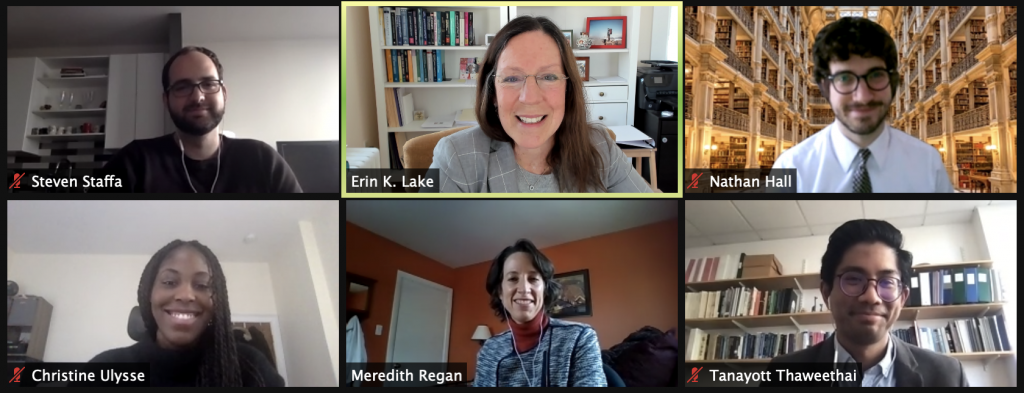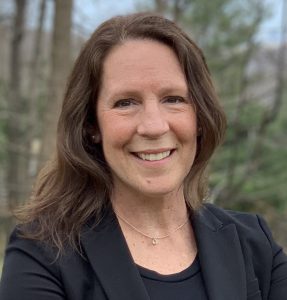
Steven Staffa, Erin Lake, Nathan Hall, Christine Ulysse, Meredith Regan, and Tanayott Thaweethai joined an audience of nearly 40 graduate students comprised of both PhD and master’s degree candidates in biostatistics.
 Erin Lake is instructor of biostatistics, co-director of the master’s in biostatistics program, and director of student development in the department of biostatistics at the Harvard T.H. Chan School of Public Health. She co-authors methodological and applied studies on topics ranging from nonlinear effects and machine learning to mental health and COVID-19, mentors more than 10 thesis students a year, and teaches core curriculum. She developed the Career Development Series to expose students to opportunities afforded by their training and facilitate a knowledge-experience continuum involving students, alumni, faculty, and professionals in the field.
Erin Lake is instructor of biostatistics, co-director of the master’s in biostatistics program, and director of student development in the department of biostatistics at the Harvard T.H. Chan School of Public Health. She co-authors methodological and applied studies on topics ranging from nonlinear effects and machine learning to mental health and COVID-19, mentors more than 10 thesis students a year, and teaches core curriculum. She developed the Career Development Series to expose students to opportunities afforded by their training and facilitate a knowledge-experience continuum involving students, alumni, faculty, and professionals in the field.
COVID-19 has thrust clinical health care workers across the globe to the frontlines of their respective institutions and communities since March 2020. The last 13 months have also shed light on another genre of health care worker—one whose training and focus is … well … more quantitative.
The biostatistician working in the hospital research setting is in clear focus and high demand of late, during a time when clinical research teams and institutions pursue knowledge and information from data.
The SARS-CoV-2 pandemic has indeed been a driver behind the need for individuals with such training. However, long before the coronavirus unleashed its impact on the world, biostatisticians in hospital research settings held critical roles as independent researchers and cross-disciplinary team members, consistently interfacing with clinicians, administrators, and other scientists.
Such biostatisticians study acute, chronic, and emerging diseases—along with other medical and public health issues—through the lenses of missing data methods, adaptive clinical trials, Bayesian designs, machine learning approaches, and more. Biostatisticians in this setting focus on topics including hereditary, deficiency, communicable and physiological diseases, mental health, drug development, injury, pregnancy and perinatal health, methods for working with EHR data, and health policy.
The statistician is often the researcher closest to a patient’s vital study details, the mind behind a study design, and the discerner of overarching patterns in any data collected, as well as overseer of all details in between. The statistician is almost always the first to uncover the inevitable and oftentimes personal story told by the data.
Meredith Regan
ScD, 1998, Dana-Farber Cancer Institute, Harvard Medical School
Research: cancer studies and clinical trials, lab and clinical work analysis, translational research
Christine Ulysse
SM, 2017, Massachusetts General Hospital
Research: Acute Respiratory Distress Syndrome (ARDS), cancer clinical trials, Parkinson’s disease
Nathan Hall
SM, 2018, Massachusetts Ear and Eye
Research: ophthalmology, consulting
Steven Staffa
SM, 2016, Boston Children’s Hospital
Research: pediatric anesthesia and surgery, clinical trials, translational research, consulting
Tanayott (Tony) Thaweethai
PhD, 2020, Massachusetts General Hospital, Harvard Medical School
Research: COVID-19, observational studies, missing data, electronic health records, diabetes and hypertension during pregnancy, consulting
Decidedly, the biostatistician in the hospital research setting is on the data frontline.
In mid-February of 2021, the Harvard Department of Biostatistics welcomed a panel of five department alumni working in hospital research settings back to the Harvard T.H. Chan School of Public Health (virtually) to share with students via the department’s Career Development Series. Meredith Regan, Tanayott Thaweethai, Christine Ulysse, Steven Staffa, and Nathan Hall joined an audience of nearly 40 graduate students comprised of both PhD and master’s degree candidates in biostatistics.
Fair game topics included the array of existing opportunities in the hospital career setting, caveats and myths around such roles, research topics and challenges, career advice, mentoring and work environment, critical skills, preferred programming languages, criteria around promotions, tenure versus research track, work-life balance, teaching options, service aspects, and involvement in the field beyond one’s institution. Salient themes around hospital research setting roles that emerged from the discussion are summarized below.
-
Methods are driven by real-world problems. How do you turn someone’s scientific or clinical question into a statistical question, and then either develop methodology or find methods to answer it? Research in this setting is organic, original, driven by real-world medical and public health challenges, and incredibly collaborative in application. The guests concurred there is nothing boilerplate about their work and it requires strong listening skills to figure out what the questions are, where the gaps in knowledge and information are, and where the best methodological solution might be found.
“I have been faced with really challenging statistical methodology questions that have required a significant amount of original research—nothing has been trivial,’ exclaimed Thaweethai. “Every study has its own quirks that require different statistical strategies and perspective.”
-
Environment and mentoring matter. Knowing the environment you will be working in is critical. Is it supportive and mentoring? Look for good mentors and be ready to both mentor and be mentored in your role.
“Also, differences between master’s and PhD roles vary by institution/group and environment and may consist more of research support versus developing and applying methodology, but most start out with a lot of support along the learning curve of a new role,” shared Ulysse.
There are also teaching opportunities in many institutions—both in and out of the classroom, as well as opportunities for service.
-
Communication and translation are key skills.
“Listening and translating clinical/policy/basic science concepts into actionable statistical methods and coding are invaluable skills in this setting,” offered Hall. “Being able to clearly communicate results, both verbally and in writing, back to nonstatisticians is critical.”The guests agreed these are often skills not directly taught in school—how to ask the most meaningful questions and being okay out of your comfort zone when it comes to clinical domain expertise.
“We all practiced methods using homework or project data sets, but how to actually plan and design a real-world study is another journey altogether, and if you can gain even a brush with this experience while still in school, it will prove helpful,” said Regan.
“Applying methods learned in school to real-world analysis while still in school via an internship or research project has huge value,” said Hall.
“Get involved in collaborative research or consulting while in school. Go beyond your dissertation or thesis,” suggested Staffa.
“There is always so much new out there to grasp and master,” exclaimed Ulysse.
-
You can usually use your favorite programming language/software. The panelists concurred that they are each free to employ whatever languages and software they feel most comfortable with and they are always provided and supported by their institutions. R, SAS, SQL, Stata, and R Shiny were reported as favorites, with the use of one or two of these varying by individual. Each guest admitted flexible, opportunistic use of their respective favorite programming languages to achieve different goals. Several noted it was helpful to have been a teaching assistant as a student, since it often requires learning a language/software other than that used in one’s own dissertation/thesis or courses. Such familiarity becomes helpful when a coinvestigator is only familiar with SAS or Stata, say, and the biostatistician is consulted.
-
Work-life balance is generally good.
Consensus across the panel was that work-life balance is generally quite good. Work can at times come in spurts around grant deadlines for instance, or … when a pandemic hits. Several reported it is harder to put work down of late due to working remotely during COVID times, but this is not reflective of only hospital settings. One pet-peeve shared: Physicians sometimes want to meet at 6:30 a.m.! -
Communication and coding skills are important when applying for a job.
The five panelists strongly encouraged meeting and learning about the people—one’s potential colleagues—during the application and interview process. “It is not just that you want them to like you—you need to feel you will flourish there,” said Staffa.Now on the hiring side, the panelists shared that employers are looking for applicants to demonstrate strong statistical skills but also great communications skills. Many ask for code samples and writing samples before the interview stage. Creating a portfolio on GitHub is helpful as a means for displaying course projects, research, or internship results and can be linked directly from one’s résumé or cover letter.
The panelists noted that seeing how an applicant turns code for a class assignment into a clear presentation, or simply how they organize their code in general, is helpful in understanding an applicant’s strengths. Why? “Studies never go away,” noted Regan.
The need to write strong, organized, annotated code that can be followed by multiple team members, along with files and directories, is critical to maintaining the clarity and integrity of a study over time, according to several panelists.
When asked for their final words of wisdom, all the panelists pointed toward finding what it is you most want to focus on and what most excites and inspires you.
“What will you want to be known for in 30 years,” asked Regan, quoting a mentor of her own at the start of her career more than 20 years ago. “I knew that I wanted to have a very direct contribution to changing the care for patients. This was very helpful for me in choosing a medical center research setting, where I could collaborate with inspiring colleagues and work on teams with a shared goal. Nothing helped me think through my wishes and future as much as that simple question from my adviser many years ago.”
“Think about the way that you want to use biostatistics to help better the world,” shared Thaweethai.
“The need for developing novel methods abounds, then applying these methods and ultimately changing the course for patients,” offered Regan. “If you are inspired by this goal, moved by collaborating with a dedicated team toward such, then a hospital research setting is for you.”




Leave a Reply